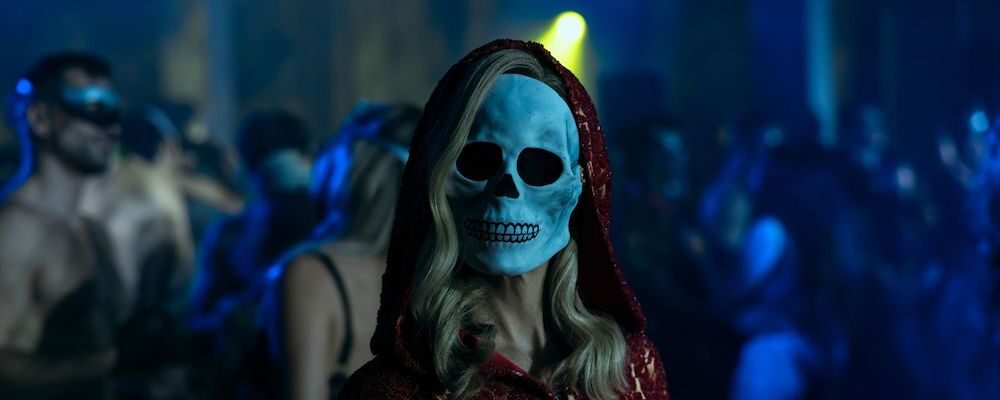‘The Fall of the House of Usher’ Targets the Rich With Brutal Modern Fables Inspired by Edgar Allan Poe
Alci Rengifo
Readers of Edgar Allan Poe will start streaming Mike Flanagan’s “The Fall of the House of Usher” expecting an updated adaptation of the master’s famous short story. Instead, Flanagan and a team of writers and directors use the great American writer’s fable of a cursed dynasty to tell some eerie, gruesome variations of Poe’s most famous stories. This could have worked just as well as an anthology series, but Flanagan wants to set it in the present as a takedown of corporate greed. With late stage capitalism being the talk of the town, the super rich are more frightening than any ghouls. While the Ushers of the series are its most unsavory beasts, horror fans will still find plenty of supernatural spooks and gore to hit the spot.
It all does begin very Poe-like. On a dark and stormy night, patriarch Roderick Usher (Bruce Greenwood) invites investigator C. Auguste Dupin (Carl Lumbly) for a sit down. Usher wants to explain the long and dark story of his family, a chunk of who have died under notorious circumstances. Haunted by the appearance of a vengeful specter, Verna (Carla Gugino), Usher wants to get off his chest the terrible tale of his clan. The Ushers’ wealth comes from pharmaceuticals, which Roderick ran with his twin sister, Madeline (Mary McDonnell). It’s no surprise that flashbacks reveal how Roderick and Madeline were always selfish and vile. That legacy now dooms Roderick’s offspring, who he had with six different women but recognized them all. Camille L’Espanaye (Kate Siegel), Leo Usher (Rahul Kohli), Victorine LeFourcade (T’Nia Miller), Tamerlane Usher (Samantha Sloyan), and Frederick Usher (Henry Thomas) were the rotten family tree that was torn down.
Just how these Ushers met their fates is the show’s sly tool to then incorporate elements from famous Poe stories. Each of the eight episodes is named after a particular selection. Fans of the writer can have fun deciphering how the plots of “The Masque of the Red Death” and “The Raven” are turned into the death knells of this most despicable family. Oh, and Frederick’s first wife was named Annabelle Lee (Katie Parker), in a charming nod at a famous Poe poem. The Ushers’ legal fixer is Arthur Pym (Mark Hamill), named after Poe’s sole novel, “The Narrative of Arthur Gordon Pym of Nantucket.” Go ahead and read the original “The Fall of the House of Usher” short story or watch the Roger Corman classic from 1960, but they only form bits of the ingredients used here. However, admirers of Flanagan’s “The Haunting of Hill House” and “Midnight Mass” will find much of the director’s signature throughout. He’s always been character-driven and knows how to combine memorable personas with the grisly scares. Yet, this series is also in the tradition of recent dramas and satires targeting the corrupt elite. The Ushers’ company, Fortunato, peddles risky drugs in a ways reminiscent of the corporate greed behind the opioid crisis.
How the Ushers waltzed into their deaths is horrendously funny to behold. Young Prospero Usher (Sauriyan Sapkota), who lives and dresses like a wannabe influencer, gets into serious debt and decides to cover it by hosting a massive, expensively exclusive orgy. The episode, “The Masque of the Red Death,” delivers on how the story should go and climaxes with much bloodshed and screeching nakedness. Camille is a depraved corporate boss who has threesomes with her two slaving assistants under contract. When they fall in love, she can’t believe it and fires them. The way her fate gets sealed in “Murder in the Rue Morgue” is animalistic and cruelly hilarious. Flanagan is out to both unnerve and poke at the funny bone. He understands Poe himself had a sense of humor beneath his rich, gothic imagination. Victorine takes credit for life-saving devices mostly designed by her partner, Dr. Ruiz (Paola Nuñez). It all gets settled in one of the best episodes of the series, “The Tell-Tale Heart.” Always present is Verna, who takes on the various forms of the creatures and critters that kill off the Ushers. It’s a great role for Flanagan regular Gugino.
Some of “The Fall of the House of Usher” can feel too long. Episodes clock in at about 60 minutes each, with the final episode, “The Raven,” going into feature length territory. Because most of the Ushers are so despicable, the show’s high quality still doesn’t make it any easier to actually care about the characters. Some have a bit of empathy while the bystanders and friends are the true victims. Watched in portions, it works well however as a gothic portrait of our worst selves. Everyone is performing with the joy of letting out their most acidic selves. Even Bruce Greenwood’s aging and reflective patriarch speaks with the arrogance of a powerful man who gets whatever he wants. “The Fall of the House of Usher” gives him his just desserts, while celebrating the idea that Edgar Allan Poe’s nightmares are as creepily relevant and dastardly eloquent as ever.
“The Fall of the House of Usher” begins streaming Oct. 12 on Netflix.

